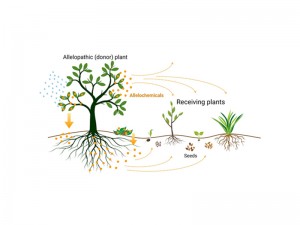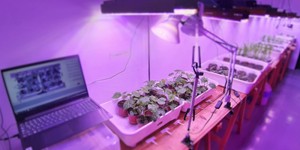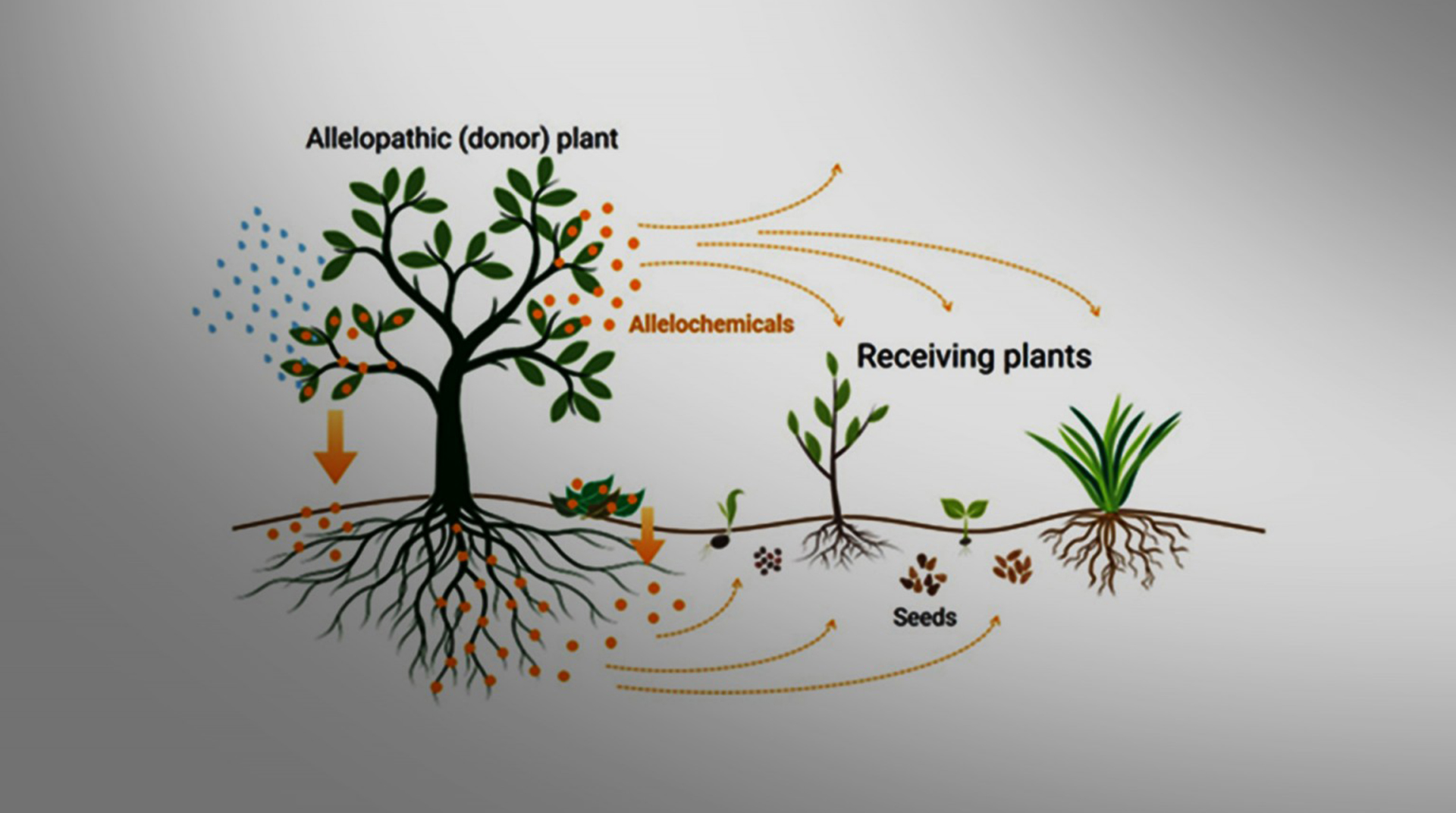What is allelopathy all about? And, how can we use this natural process for weed management and crop protection?
Allelopathy refers to the effects of one plant on another one, through the release of chemical compounds or biochemicals, which are known as allelochemicals. Different parts of a plant (leaves, flowers, roots, etc.) can deliver these compounds to the surrounding environment by leaching, root exudation, volatilization, residue or organic matter decomposition, and other processes in both natural and agricultural systems.
Allelochemicals belong to a subset of plant metabolites, which are not essential for growth and development (primary metabolism) of plants and, because of this, are called secondary metabolites. These secondary metabolites mediate plant-environment interactions and they are important for plants to cope with stressful conditions. They are key components of plant defenses against herbivory (i.e. animals or insects eating plants as their primary food), microbial plant diseases (i.e. bacterial or fungal phytopathogens), or competitive plants (i.e. other plants competing by resources such as water, sunlight or nutrients).

Illustration of the allelopathic effect. The arrows show different ways plants can release allelochemicals to the surrounding environment.
Two sides of the same coin
The last mentioned ability of allelochemicals to act on seed germination, or to inhibit or retard the growth of other plants, can certainly be a problem for agricultural production by promoting weeds interference with crop development. However, the same natural capacity makes these plant metabolites natural herbicides or bioherbicides, which can be found in several wild plants specially growing under certain stressful environments.
What if we could harness this natural herbicides for agricultural uses? With that idea in mind, we started the research and discovery project of INBIOAR around ten years ago. Along this time we have developed and improved (this is a continuous process) a library of plant extracts and a method to search for novel natural ingredients for herbicides as well as other crop protection products. We use naturally occurring plants from the field or the roadsides to find those producing allelochemicals with negative effects on other plants. This process of searching, evaluation and selection of those interesting plants is what we call the Method.
Plant natural products possess main benefits such as chemical diversity and potentially novel structures in addition to multiple modes of action, which can contribute to the management of resistant pests; shorter half-life than synthetic herbicides and biodegradability; and even some of these bioactive extracts also have unexplored properties.
Natural solutions for the crop protection industry
Technology transfer is a fundamental link in the new product development chain. There is a motivating opportunity on providing those companies interested in the innovation and development of natural products with new botanical active ingredients for the crop protection market. The research and discovery process is based on scientific knowledge and a strict protocol of evaluation and selection of naturally occurring compounds produced by plants. Through this process we can find herbicidal, stimulant, antifungal or insecticidal leading plant extracts with potential for commercial development. In fact, three of these leading samples were transferred to agrochemical companies for testing under exclusive and confidential conditions. And we continue testing the library searching for other plants with significant properties.
On the bioherbicides, from our experience, some of them would seem to have contact effects, while there was one showing progressive results indicating a potential systemic effect. On the other hand, an antifungal extract actually prevented certain diseases such as potato late blight for example. Several natural products act as elicitors or stimulants of plant defenses. Since this extract would not seem to have significant inhibitory ability when applied directly on the phytopathogen, this possible mode of action needs to be assessed. Elicitors are a promising generation of crop protection tools, because they produce an effect by priming plant defenses, thus reducing environmental impact.

The research and early development process of a new product demands a sustained and solid scientific work. Apart from proving the efficacy of those leading extracts through lab experiments or greenhouse and field trials, identification of the specific allelochemicals or natural pure compounds is a major step for future production, registration and understanding of the mode of action. Working jointly with specialists in natural product chemistry, and by using different purification and analytical tools, we have reached for example to the pure active ingredients (bioherbicidal molecules) of different plants.
Innovation has no borders
After traveling thousands of kilometers searching for the best plant samples and testing more than 2600 extracts, we realized we had developed strategic knowledge and experience. This is fundamental to identify not only how, but also where and when collecting plants expressing their greatest biochemical potential. That is why we are taking this experience to other areas and generating alliances with companies and research institutions in different regions to study diverse samples and produce “in house” the natural extracts.
Several factors are driving changes in the agricultural systems. The growing world population increases the demand for food, both in quantity and quality. In parallel, health and environmental consciousness drives consumers demand for low-residue products and best quality food. Following these social claims, global policies and initiatives, such as the Sustainable Development Goals of United Nations for example, have emerged to manifest this awareness and the engagement with promoting prosperity while protecting the planet.
It is clear that novel strategies are badly needed to manage the evolution of resistant pests and weeds, while taking care of the food quality and safety. This represents a global challenge however, it can be addressed as an opportunity. We can find inspiration in nature itself and mimic its strategies, such as allelopathy, in order to contribute with integral and sustainable crop protection practices.
Today, the future is asking us for more natural and sustainable tools to maintain production while preserving the environmental natural conditions.
Link to the article: http://news.agropages.com/News/NewsDetail—39959.htm




